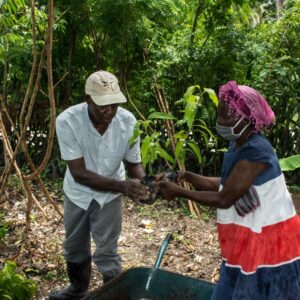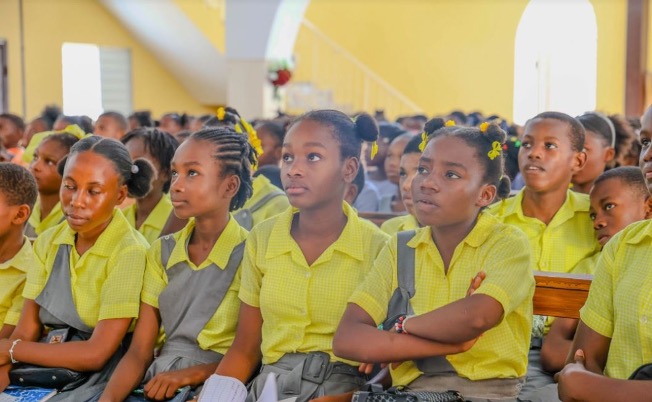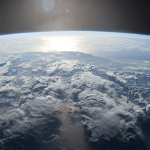Nancy Roc ak Paul Judex Edouarzin
As part of the Sustainable Coastal Tourism Program (TCD) funded by the Inter-American Development Bank (IDB), the Executive Technical Unit of the Ministry of Economy and Finance (UTE/MEF) together with the Ministry of Tourism and the Ministry of Environment-ANAP will support prevention activities against natural disasters and climate change to children and adolescents in the South, a project proposed by the Haitian company, Incas Productions.
Together with the Federation of Haitian Protestant Schools (FEPH), Incas Productions sensitized almost 600 students during the webinar on June 13 and 14, 2024 in Saint-Louis di Sud, on the theme of “kelp: between inconvenience and opportunity”. and in Aachen on the theme “Young people face climate disasters: what is resilience?”
Since 2011, kelp has invaded southern Haiti. These algae, although natural, are spreading in an alarming way due to climate warming and the discharge of nutrients into the Atlantic Ocean. According to researchers at the University of South Florida, these large brown algae blooms can be attributed to nitrate discharges in the Amazon River. [[1]. Ocean currents, aggravated by extreme weather phenomena, transport these masses of algae across the Caribbean and onto Haitian beaches, creating a major problem for people. In fact, regardless of whether it is in Saint-Louis, Okay or Jakmèl, kelp poses a serious threat to public health in Haiti, especially for children. Their massive proliferation, attributed to global warming and pollution, transforms beaches into veritable marine deposits. The effects on health are many and alarming: as they decompose, the sargassum releases hydrogen sulfide, a toxic gas responsible for respiratory disorders, skin irritation and headaches. In addition, tourists – in the Caribbean, because there are no more in Haiti because of the gangs – avoid infested beaches, causing an economic collapse for local communities that depend on tourist activities.
Adverse effects
In fact, regardless of whether it is in Saint-Louis di Sud, Okaya or Jacmèl, when the kelp invades the coasts, the gases from their decomposition can cause respiratory irritation, nausea and other health problems for the population, especially children, who are live near affected areas. Water contamination caused by kelp can pose a risk to drinking water supplies, while this is already a critical problem in Haiti. Kelp disrupts local marine ecosystems, suffocating underwater life and vegetation. Corals, which are essential for marine biodiversity and coastal protection from erosion, are especially affected. The decomposition of kelp, while releasing hydrogen sulfide, contributes to water acidification, endangering marine species and fisheries, which are a vital resource for coastal communities in Haiti.
The accumulation of these algae also disrupts human activities. The beaches, which were once important tourist resources, have become impractical, causing a significant decline in income for the people. Fishing boats, blocked by seaweed piles, are difficult to navigate, endangering the livelihood of local fishermen. Faced with this ecological crisis, it is important for the Haitian authorities, in partnership with regional organizations, to develop sustainable management strategies and effective cleaning to preserve the ecological balance and sustain the threatened local economy.
An unexplored opportunity in Haiti
While kelp poses a threat to tourism and marine ecosystems, they also offer a number of economic and environmental opportunities. There are many initiatives in the Caribbean that show that kelp can be transformed into a precious resource, and Haiti could benefit greatly from these innovations.
In many regions of the Caribbean, kelp is used as an organic fertilizer. For example, in Puerto Rico [[2], agronomists began incorporating kelp into compost, which improved soil quality and reduced the use of expensive chemical fertilizers. Algae Organics [[3] is a company in Saint Lucia that transforms kelp into biofertilizer. Economic models show how kelp can be transformed into value-added products, creating local jobs and supporting sustainable agriculture. Haiti, with the land it has, could adopt this practice to revitalize the depleted land and increase agricultural productivity, while nearly five million Haitians are suffering from hunger and need food aid, according to the latest figures from the UN [[4].
In Martinique, kelp is used to manufacture ecological building materials such as bricks and insulating panels. These products are not only durable but also economical [[5]. In Haiti, where reconstruction after natural disasters is a priority, the use of kelp to produce building materials can represent an important advance.
Algae can also be turned into biofuel. In Mexico [[6], an innovative company has developed a process to convert these algae into biomethane, a renewable energy source. This technology may be a possible solution for Haiti, which seeks to diversify its energy sources and reduce its dependence on imported fuel.
Seaweeds are rich in bioactive compounds, which are used in the cosmetic and pharmaceutical industries. In Guadeloupe [[7], a company successfully extracted the anti-inflammatory and anti-oxidant substances of sargassum to create skin care products. Haiti, with its potential in the development of the natural cosmetics sector – such as Maskriti oil, to cite an example – can exploit this resource to create high-level value-added products.
There are many opportunities, but there are also many challenges to make the best use of kelp in Haiti. Seasonal changes in kelp availability, collection and processing costs, as well as environmental issues such as arsenic levels, are major issues standing in the way. In order to overcome these challenges, we need more research, investment in treatment technology, and cooperation at the regional level. But while we wait for a solution to the permanent safety problem, several children in Senn-Lwi-du-Sid now know that kelp is not just garbage. And what do you know? Maybe one of them will have an inspiration to change things in his community one day.
Follow the AlterPresse/AlterRadio channel on WhatsApp – CLICK HERE
[[1] ‘’ The great Atlantic Sargassum belt’’, Revue Scince, 5 Jul 2019, Vol 365, Issue 6448, pp. 83-87
[[2] Christine J., USA – Puerto Rico: Firm Rejection of Sargassum Use as FertilizerMarch 15th, 2024, Sargassum Monitoring
[[3] Marlowe Starling, , Caribbean startups are turning excess seaweed into an agroecology solution, April 16th, 2024, Mongabay.
[[4] Feeding Haiti in times of crisis: five things to know, UN News, April 1, 2024.
[[5] Valorization of Sargassum: launch of two projects in the French Antilles, ADEME in Guadeloupe
Ecological Transition Agency, 2020.
[[6] Marlowe Starling, Caribbean startups are turning excess seaweed into an agroecology solution, April 16th, 2024, Mongabay.
[[7] Jacques Vilus, Sargassum could become medicineFrance-Antilles, April 4, 2024.






